These Lavender Lemon Bars are a sweet twist on traditional lemon bars! Homemade lavender sugar is used in the crust and filling to add a light floral flavor. They’re tangy, sweet, and refreshing!

🍋 Lemon and Lavender: The Perfect Pair
These lemon bars are extra special because they have a floral twist: they’re made with lavender sugar in both the shortbread crust and the lemon filling. The lavender gives the bars a light, fresh floral taste that pairs perfectly with the bright flavor of lemons.
I know not everyone will be immediately excited about adding lavender to such a classic, timeless recipe. Why mess with perfection? But if you’ll give me a moment, I think you’ll be persuaded to give them a try, because the lavender doesn’t detract from the lemon bars – it enhances them in the best way possible.

🪻 What’s Lavender Sugar?
“Lavender sugar” may sound fancy, but it’s literally something you whiz up in the food processor right before you make the lemon bars. It’s made with dried lavender and granulated sugar, for a total cost of 50 cents and a time commitment of 20 seconds (those are estimates, but you get the idea.)
Lavender sugar is such a lovely ingredient. It’s very aromatic, with a woodsy, vanilla fragrance and a mildly herbal taste. It’s a great pantry item because it keeps for ages, and it’s a wonderful addition to hot drinks, lemonade, or cookie recipes.
While this recipe calls for just the amount of lavender sugar you’ll need, you can always make more and keep it in your cupboard to add to coffee, cakes, or anything else that could use some flower power! Get more info and grab my printable lavender sugar recipe here.
More Lemon Dessert Recipes
Don’t get me wrong, I love all kinds of fruit desserts. Give me the raspberries, blackberries and blueberries! But if you really want to make me smile, pair those beauties with the sweet-tart flavor of lemon.
You’ll want to try my Lemon Meringue Teacup Cakes with raspberries, Lemon Mousse Cakes with mixed berries, Lemon Blackberry Trifle and Raspberry Lemon Meringue Trifle to find out exactly what I mean!
Table of Contents
🧾 What You’ll Need
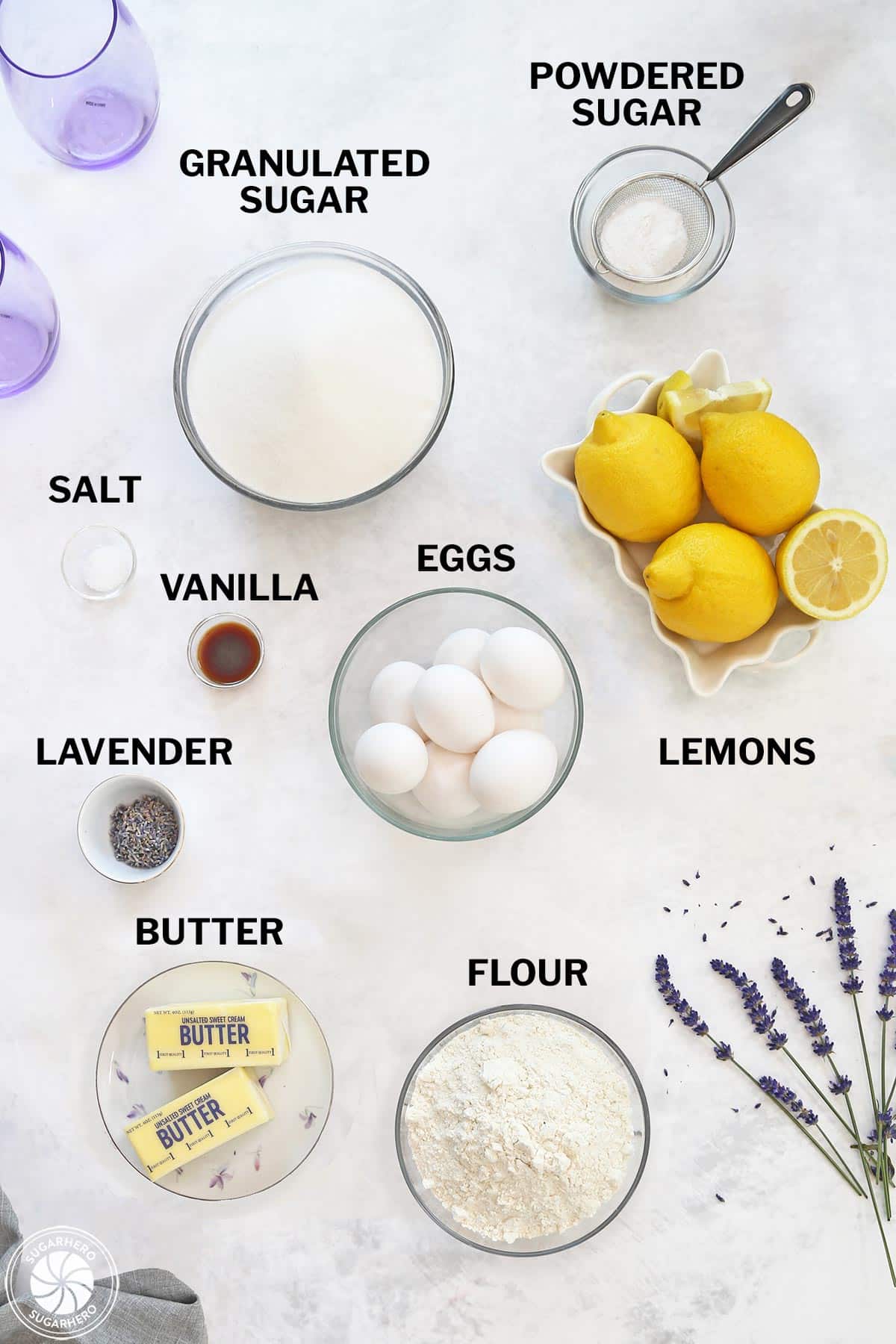
Ingredients
With the exception of the dried lavender, you’ll just need a few baking basics to make these fresh springy bars. Full ingredient amounts can be found in the recipe card below. (Links are affiliate links and I earn a small commission from qualifying purchases.)
For the Lavender Sugar
- Sugar: You’ll need regular granulated sugar to as the bulk of the lavender sugar.
- Culinary dried lavender: Make sure to use lavender dried for culinary purposes. (For lots more information see our full guide to culinary lavender here!) You can often find culinary lavender near the spices in the baking aisle of large supermarkets. Or, of course, dried culinary lavender is also available online.
For the Crust
- Butter and salt: I prefer to use unsalted butter in my baked goods so that I can control the salt more precisely. If desired, you can use salted butter, but omit the additional salt in the recipe.
- Lavender sugar: You’ll need to prepare your batch of lavender sugar just before making the bars. It’s very easy!
- Vanilla extract: I love the additional pop of flavor in the crust from added vanilla extract.
- Flour: Use all-purpose flour for the base of the crust. Make sure to measure the flour correctly. Too much flour will make your crust overly dense. I recommend using a food scale if possible. If you don’t have a scale, measure by scooping the flour into a measuring cup, then leveling off the top with the back of a knife.
For the Filling
- Eggs: The filling will need 8 large eggs. Make sure they’re not medium or extra large.
- Lemon juice and zest: To get the very best flavor, use freshly squeezed lemon juice and freshly grated lemon zest. You can use store-bought lemon juice, but in my opinion the flavor is not nearly as good.
- Lavender sugar: Adds a delicious and unique floral flavor.
- Flour: The all-purpose flour in the filling helps to bind everything together and gives the filling a creamier texture.
- Powdered sugar and lavender buds: Regular powdered sugar works fine, but melts into the bars after awhile. I like to top my bars with non-melting powdered sugar, which, as the name suggests, won’t melt into the bars due to condensation. You can buy non-melting sugar at King Arthur Flour. I also think the bars look pretty with a sprinkling of lavender buds on top.

Equipment
You’ll just need a few tools to make these special lemon bars. (Links are affiliate links and I earn a small commission from qualifying purchases.)
- Food processor: In order to get the lavender buds small enough to use in the sugar, you’ll need a food processor or food grinder.
- Baking pan: I’d recommend using a metal 9×13 pan because it helps to crisp the crust. However, you can use any 9×13 pan you have on hand. Line it with non-stick foil or parchment.
- Sifter:I like to use a small sifter to sprinkle the powdered sugar onto the Lavender Lemon Bars. It gives the top of the bars a soft, even coating of sugar.
- Microplane: When zesting citrus fruits, it’s helpful to use a microplane. If you don’t have one, you can also use a box grater.
- Juicer: If possible, you’ll want to use fresh lemon juice in your bars. Although optional, a hand juicer makes the juicing process quicker and eaiser.
- Chef’s knife: To get nice, clean cuts, use a sharp chef’s knife when it’s time to cut the bars. Check the tips below for more information about clean cuts.

Ready to Make These?
- Get the recipe below 👇👇
- Scroll below the recipe for step-by-step photos
- Read important Tips and FAQs
🌺 More Lavender Desserts
Leave a Review!
If you make this recipe, let us know! Leave a ⭐️⭐️⭐️⭐️⭐️ rating on the recipe below, and leave a comment, take a photo and tag me on Instagram @elabau, or use #sugarhero on IG!
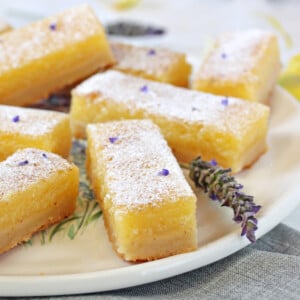
Lavender Lemon Bars
Ingredients
For the Lavender Sugar:
- 22.75 oz granulated sugar, (3 ¼ cups)
- 2 TBSP culinary dried lavender
For the Crust:
- 8 oz unsalted butter, (1 cup), melted and slightly cooled
- 3.5 oz lavender sugar, (1/2 cup)
- 2 tsp vanilla extract
- 1/2 tsp salt
- 9 oz all-purpose flour, (2 cups)
For the Filling:
- 8 large eggs
- 1 ¼ cups fresh lemon juice
- 19.25 oz lavender sugar, (2 3/4 cups)
- Zest of 2 lemons, (about 2 TBSP)
- 2.25 oz all-purpose flour, (1/2 cup)
- Powdered sugar, for serving
Instructions
To Make the Lavender Sugar:
- Place the dried lavender in the bowl of a food processor and blend it for 10-15 seconds to chop it into small pieces. Add 1 cup of granulated sugar to the processor and blend well, for 15-20 seconds, until the lavender is finely ground and mixed into the sugar. Add the remaining sugar to the processor and pulse briefly until it’s well-mixed.
To Make the Crust:
- Preheat the oven to 350 degrees Fahrenheit. Line a 9×13 pan with foil so that it extends up the sides, and spray the foil with nonstick cooking spray.
- In a bowl, whisk together the melted butter, lavender sugar, vanilla, and salt. Once mixed, add the flour and stir with a spatula until it is combined and no streaks of flour remain. Scrape the dough into the pan and press it into an even layer. It might seem a little greasy—this is normal.
- Bake the crust for 25-30 minutes at 350 F, until it’s golden brown on top. While the crust is baking, prepare the filling so it’s ready to go as soon as the crust is done.
To Make the Filling:
- In a large bowl, whisk together the eggs, lemon juice, lavender sugar, and lemon zest. Sift the flour on top of the egg mixture, and whisk it in as well.
- When the crust is done baking, slide the rack part-way out of the oven. Pour the filling over the hot crust and slide it back into the oven. Reduce the temperature to 325 F and bake for 25-30 minutes. It’s done when the center barely jiggles when you tap the pan.
- Once done, remove the pan from the oven and let it cool until it reaches room temperature. For the cleanest cuts, refrigerate the bars and cut them when completely cold. To cut, remove the bars from the pan using the foil as handles. Use a large sharp chef’s knife and wipe it off often between cuts.
- Sprinkle the top with powdered sugar before serving, and add a few lavender buds on top if desired. Store Lavender Lemon Bars in an airtight container in the refrigerator for up to a week.
Recipe Notes
Measuring Tips
Our recipes are developed using weight measurements, and we highly recommend using a kitchen scale for baking whenever possible. However, if you prefer to use cups, volume measurements are provided as well. PLEASE NOTE: the adage “8 oz = 1 cup” is NOT true when speaking about weight, so don’t be concerned if the measurements don’t fit this formula.
Want to learn more about baking measurements and conversion?
Nutrition
📸 Photo Tutorial: How to Make Lavender Lemon Bars
Use this photo tutorial to guide you through the steps of making Lavender Lemon Bars. Check the recipe card for full instructions.
Lavender sugar is used in both the shortbread crust and the lemon filling, to give the bars a very light floral flavor. “Lavender sugar” may sound fancy, but it’s something you can whip up in just a few minutes with a food processor or spice grinder. For more in depth instructions, check out my tutorial about how to make lavender sugar.


Make the Lavender Sugar
- Pulse dried lavender. Place 2 TBSP dried lavender in the bowl of a food processor and blend it for 10-15 seconds to chop it into smaller pieces.
- Add 1 cup sugar and blend. Add 1 cup of granulated sugar to the processor and blend well, for 15-20 seconds, until the lavender is finely ground and mixed into the sugar.


- Add remaining sugar. Add the remaining 2 1/4 cups sugar to the processor, and pulse briefly until it’s well-mixed.


Make the Shortbread Crust
- Prepare to bake. Preheat the oven to 350 degrees Fahrenheit. Line a 9×13 pan with foil or parchment so that it extends up the sides, and spray with nonstick cooking spray.
- Mix together butter, lavender sugar, vanilla and salt. Melt 8 oz (1 cup) butter. Then, in a bowl whisk together the melted butter, 3.5 oz (1/2 cup) lavender sugar, 2 tsp vanilla, and 1/2 tsp salt.
- Add flour to dough. Once mixed, add 9 oz (2 cups) flour, and stir with a spatula until it is combined and no streaks of flour remain.


- Press dough into pan. Scrape the dough into the pan and press it into an even layer. It might seem a little greasy—this is normal.
- Bake. Bake the crust for 25-30 minutes at 350 F, until it’s golden brown on top. While the crust is baking, prepare the filling so it’s ready to go as soon as the crust is done.


Make the Filling
- Prepare lemon zest and juice. Zest and then juice 2 large lemons. Set aside.
- Whisk eggs. In a large bowl, whisk together 8 large eggs.


- Add lemon juice, lavender sugar and lemon zest. Add 1 1/4 cups lemon juice, 19.25 oz (2 3/4 cups) lavender sugar, and approximately 2 TBSP lemon zest to the beaten eggs.
- Sift flour into filling. Sift 2.25 oz (1/2 cup) flour on top of the egg mixture, and whisk it in as well.


- Pour filling over hot crust. When the crust is done baking, slide the rack part-way out of the oven. Pour the filling over the hot crust and slide it back into the oven.
- Reduce temperature and finish cooking. Reduce the temperature to 325 F and bake for 25-30 minutes. It’s done when the center barely jiggles when you tap the pan.
- Cool. Once done, remove the pan from the oven and let it cool until it reaches room temperature.
- Refrigerate. For the cleanest cuts, refrigerate the bars and cut them when completely cold. See tips below for more info.
- Finish and serve. Sprinkle the top with powdered sugar before serving, and add a few lavender buds on top if desired.

💜 Tips for Lavender Lemon Bars
- Use the right lavender: all lavender is not created equal! You want to be sure you’re using lavender intended for baking and eating. Look for “culinary lavender” near the spices in your grocery store, or find it online. For much more information, I have a full guide to baking with lavender here.
- Use the best lemons: Fresh, juicy lemons are essential for making a delicious lemon bar. Choose lemons that are heavy for their size and have a sweet, citrusy aroma.
- Don’t overmix the crust: Mix the dough just until the ingredients come together. Overmixing can lead to tough, dense bars.
- Don’t underbake: every oven is different, and your bars may take a little longer to cook. Don’t just go by time – keep them in the oven until they look set and the centers barely jiggle when the pan is moved.
- Don’t overbake: Keep an eye on the bars while they’re baking, and remove them from the oven as soon as they’re lightly golden. Overbaking can make the bars unpleasantly dry.
- Let them cool completely: Resist the temptation to cut into the bars as soon as they come out of the oven. Let them cool completely to ensure they set properly and are easier to cut.
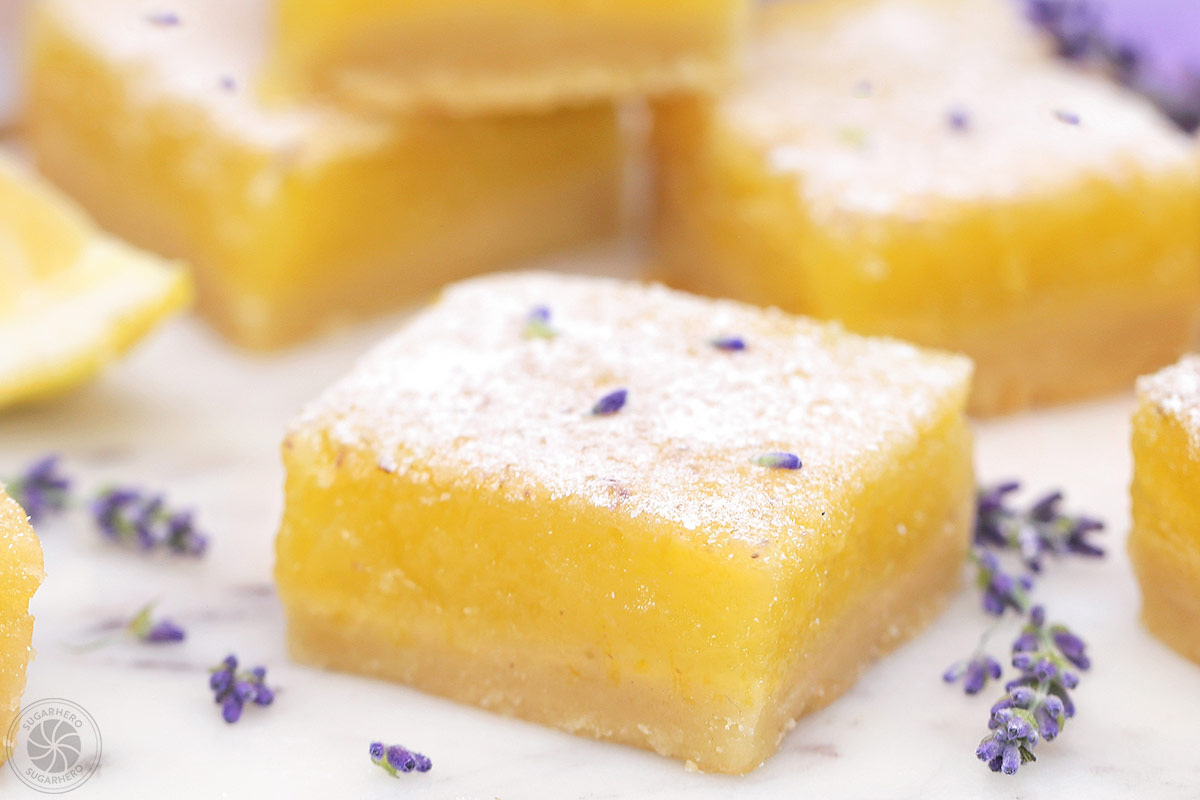
💡 FAQs
While bottled lemon juice can work in a pinch, it’s not recommended. Fresh lemons provide a more vibrant, citrusy flavor that’s essential to a great lemon bar.
There are two main differences that will make a difference in your baked goods.
1. Regular lavender (also known as English lavender, true lavender and crafting lavender) has a higher amount of oil in it than culinary lavender. Because of the extra oil, it’s more fragrant and better suited for perfumes and soaps. If you try to use it for baking, your treats will likely take on a soapy taste.
2. Culinary lavender goes through a more vigorous sifting process than crafting lavender to ensure that only the buds remain. A small leaf or stem in your soap won’t be noticeable, but it could make your treats look and taste less appetizing.
To give your baked goods the best flavor, make sure that you’re using lavender intended for culinary use.
Culinary-grade dried lavender can often be found near the spices in the baking aisle of large supermarkets. I’ve had good luck finding cheap lavender at Cost Plus World Market, if you have one of those nearby. Or, of course, dried culinary lavender is also available online.
You can use Lavender Sugar in place of regular granulated sugar in many different recipes. Try it in cookies, ice cream, cake, cupcakes, tart crusts, or bar cookies.
Yes! Lavender Lemon Bars can be made ahead of time and stored in the fridge or freezer. Simply thaw them at room temperature or in the fridge before serving.
For the cleanest cuts, refrigerate the bars and cut them when completely cold. To cut, remove the bars from the pan using the foil or parchment as handles. Use a large sharp chef’s knife and wipe it off often between cuts.
Lavender Lemon Bars can be stored at room temperature for up to 3 days, in the refrigerator fo a week, or frozen for up to 2 months. Be sure to wrap them tightly in plastic wrap or keep them in an airtight container to prevent them from drying out.
more Shortbread Desserts You’ll Love:

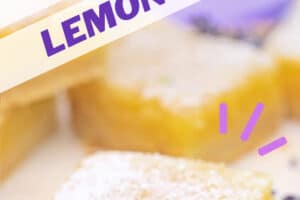
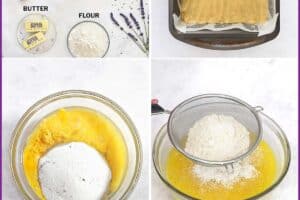


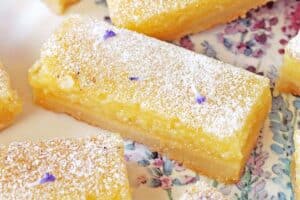
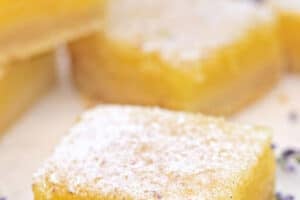


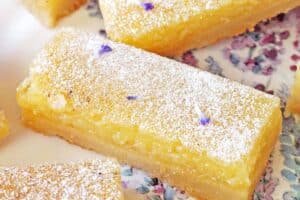



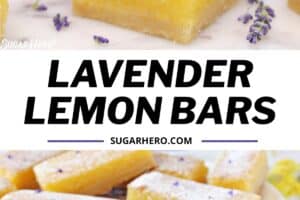

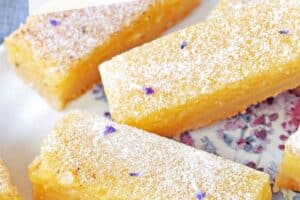





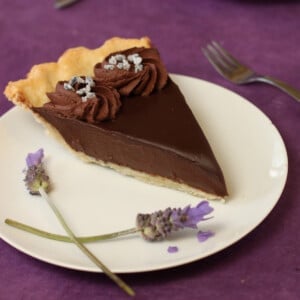
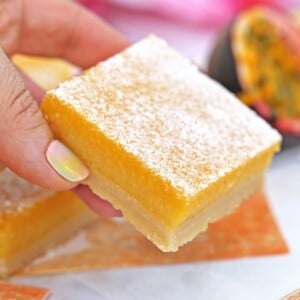
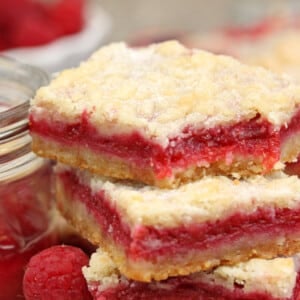

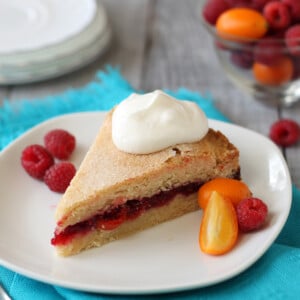
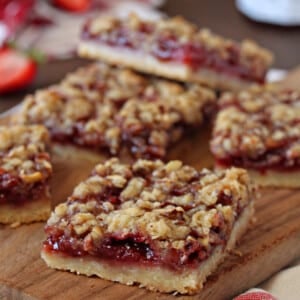
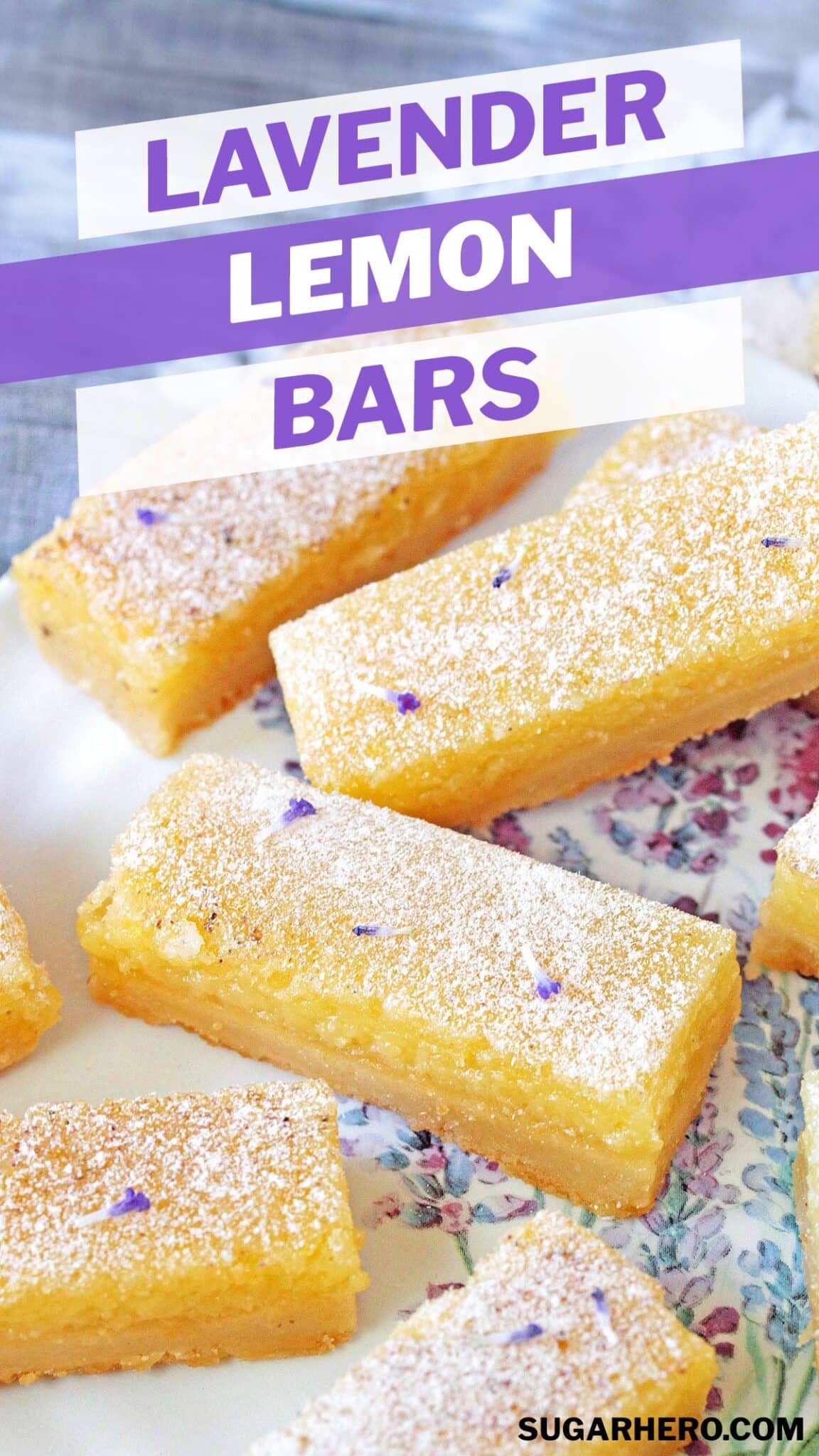




















Super easy recipe to follow and turned out amazing! My son is allergic to dairy so I subbed vegan butter 1:1 and they were perfect!
Hi Talara! Thanks for the recipe review and rating. It really means a lot. AND, thanks for the dairy-free tip. That’s so helpful for other readers. Nice to know they turned out so well with vegan butter. All the best to you!